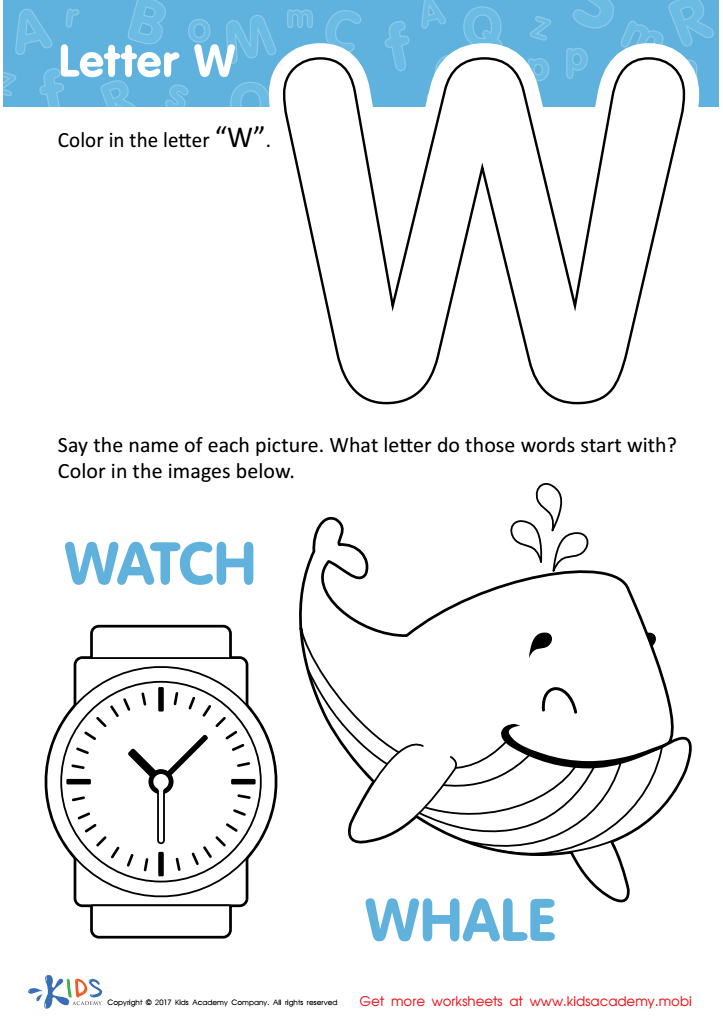-
English
-
English Pre-K
-
Unit 1: Early Literacy Skills
-
ABCs
- Pre-writing Activities
- Letter A
- Letter B
- Letter C
- Letter D
- Letter E
- Letter F
- Letter G
- Letter H
- Letter I
- Letter J
- Letter K
- Letter L
- Letter M
- Letter N
- Letter O
- Letter P
- Letter Q
- Letter R
- Letter S
- Letter T
- Letter U
- Letter V
- Letter W
- Letter X
- Letter Y
- Letter Z
-
Phonological Awareness
- Rhyming Words
- Letter Sounds B, C, D, and F
- Letter Sounds G, H, J, and K
- Letter Sounds L, M, N, and P
- Letter Sounds Q, R, S, and T
- Letter Sounds V, W, X, Y, and Z
- Letter Sounds A, E, and I
- Letter Sounds O and U
- Beginning Sounds
- Matching Letters to Sounds
-
ABCs
-
Unit 2: Vocabulary
-
Common Words
- Sorting Words into Categories
- Color Words
- Verbs and Adjectives
-
Sight Words
- Sight Words 'I' and 'Can'
- Sight Words 'You' and 'Like'
-
Common Words
-
Unit 3: Print Awareness
-
Parts of a Book
- Working with a Book
- Spaces Between Words
- Text and Illustrations
-
Picture Books and Poems
- Picture Book Text Features
- Poem Text Features
- Signs and Labels in the Community
-
Parts of a Book
-
Unit 4: Reading Literature
- Questions About Stories
- Discussing Stories
-
Unit 5: Reading Informational Texts
- Retelling Details in a Text
- Questions About a Text
- Connections Between Events
- Text Features
- Describing Illustrations
-
Unit 1: Early Literacy Skills
-
English Pre-K
-
Math
-
Math for Pre-Kindergarten
-
Logic and Geometry
-
Matching and Sorting
- Same and Different
- Which One Is a Little Different?
- Objects That Go Together
- Sorting by Color and Size
- Sorting The Same Group in Different Ways
- Patterns
-
Shapes
- Shapes in Our Environment
- Naming Shapes Regardless of Size
- Making Shapes in Preschool
- Comparing Shapes
- Relative Positions
- Sorting Shapes
-
Matching and Sorting
-
Early Number Sense
-
Numbers 1–5
- Counting to 3
- Counting to 5
- Arranging Objects up to 3 Objects
- Arranging up to 5 Objects
- Writing Numbers 1–5
-
Numbers 1–5
-
Numbers up to 10
- Counting to 10
- Arranging up to 10 Objects
- Number 0
- Writing Numbers 6–10
- Breaking Down Numbers 6-10
-
Logic and Geometry
-
Math for Pre-Kindergarten
Letter W
Now that you’re done with the letter V, it’s time to look at the letter W. Before introducing your child to this new letter, try to first integrate it into their environments. One way is to expose them to the letter visually through a “Letter of the Week'' board, set in their learning space. Other ways to do that is by pointing out objects that start with the letter W in their daily life, such as “window”, “”watermelon” and the color “white”. In addition, you can discuss the features of the letter W with your child, such as pointing out the sound and name of the letter. To further this conversation, you can suggest watching this short Letter W video created by Kids Academy that explains the important aspects of the letter.
After fully introducing the letter W, you can now move on to the activities, the fun part! In this article, you’ll find a list of five activities you can offer your child to help them learn the letter W within a week.
Activities
- Letter W Coloring Sheet: This coloring sheet from the Kids Academy website will make a great addition to the Letter W lesson. Coloring in a big bubble letter W will help your child retain the shape of the letter, while coloring in the images of a whale and a watch will help them identify the sound of the letter in addition to its shape.

- Letter W Tracing Page: Through this worksheet, your child will learn the shape of the letter W in both its capital and lowercase forms. It guides them through a tracing activity, where they will start from the red dot, and follow the arrows to complete tracing the uppercase W then the lowercase. Similarly to the previous worksheet, it provides your child with images and words that start with the letter W to help them learn the sound of the letter.

- W is for Watermelon: For this activity, you’ll need to print out the letter W, make it as big as you can, on an A4 paper. Get some red, green and black crepe or construction paper and cut them into squares, making the black ones quarter the size of the red and green. Then, have your child glue the pieces onto the letter W to make the shape of a watermelon with seeds.
- Water W: On a piece of paper, write the letter W with water, then have your child add drops of watercolor to different spots of the letter and watch the color spread. Another water activity is to have your child write the letter with a brush and some water on a chalkboard or a concrete sidewalk.
- Windmill Craft: This activity requires simple material to make a cool windmill craft. On a toilet paper roll, have your child draw some windows and color them. Then cut a big X shape and have your child pin it to the top of the toilet paper roll to make a windmill that actually turns.
Using these activities will definitely help your child learn the letter W in a fun and easy manner. For more material on the alphabet for preschoolers, use the catalogue below or visit the Kids Academy website.

